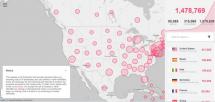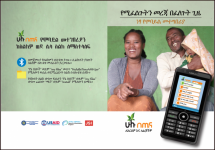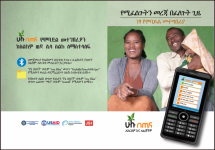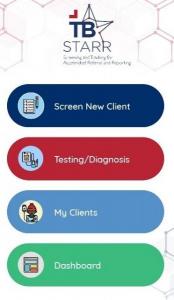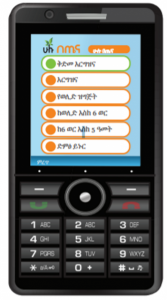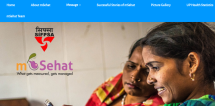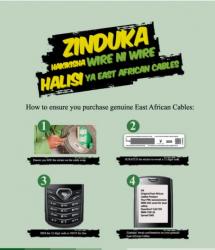Date of Publication: April 10, 2020
Type of Material: Mobile app
The Coronavirus App
This app shows a map of cases around the world. It is a third-party product using information from various sources.
Source: Scriby Inc
Date of Publication: April 10, 2020
SIMILIAR RESOURCES
Tools
Examples
- KAP COVID: Exploring Knowledge, Attitudes, and Practices for COVID-19 Prevention
- Creating Mobile Health Solutions for Behaviour Change: A Study of Eight Services in the mNutrition Initiative Portfolio
- Coronavirus — COVID-19 Factsheet
- Visualizing the History of Pandemics
- Fake News Can Be Deadly. Here's How to Spot It
- WHO Coronavirus Website
- CDC Coronavirus Website
- Coronavirus Pandemic: Tracking the Global Outbreak
- Guidance for Including People with Disabilities in Response to the COVID-19 Pandemic
- Practice Guide: Behaviour Change Communication during Crisis
Hulu Beteina Mobile App
This mobile application is developed to support rural women and couples to better manage and track their health, mainly during pregnancy, through delivery and after birth.
Designed for use on both smart and basic phones, the approach invokes a simple, easy to navigate format containing relevant, engaging, and educational content. Key features of the app include growth-monitoring tool, scheduling for ANC and immunization visit. It is available in three languages (Amharic, Afan Oromo and Tigrigna) and no internet connection required to transfer or use the application.
Source: Communication for Health Ethiopia
Date of Publication: February 11, 2020
SIMILIAR RESOURCES
Tools
Examples
- WASH FIT / WASH FIT Mobile
- SBCC for Malaria in Pregnancy: Strategy Development Guidance
- MULTI-SBC: The Programmatic Aid for Multi-Sectoral Integration of SBC for FP Practitioners
- Using Data to Design an Evidence-based Social and Behavior Change Program in Rural Nepal
- The Behavior Change Framework
- Advocating for Social Marketing Programs to Local Stakeholders
- Moving the Needle on Health Behaviors
- My Voice Service Improvement Platform
- Private Sector Counts
- La Planification Familiale dans les Situations d'Urgence: Essentielle,, Voulue, Necessaire et Realisable
Hulu Beteina Mobile App – Instructional Leaflet
This mobile application is developed to support rural women and couples to better manage and track their health, mainly during pregnancy, through delivery and after birth. Designed for use on both smart and basic phones, the approach invokes a simple, easy to navigate format containing relevant, engaging, and educational content. Key features of the app include growth-monitoring tool, scheduling for ANC and immunization visit. It is available in three languages (Amharic, Afan Oromo and Tigrigna) and no internet connection required to transfer or use the application.
This is an instructional leaflet on how to use the app as well as how to share it
Source: Communication for Health Ethiopia
Date of Publication: February 10, 2020
SIMILIAR RESOURCES
Tools
Examples
- WASH FIT / WASH FIT Mobile
- The Behavior Change Framework
- Advocating for Social Marketing Programs to Local Stakeholders
- Moving the Needle on Health Behaviors
- MULTI-SBC: The Programmatic Aid for Multi-Sectoral Integration of SBC for FP Practitioners
- Advancing Gender in The Environment: Gender in Fisheries—A Sea of Opportunities
- The Infection Control Symbol Package
- GESI Toolkit
- Using Data to Design an Evidence-based Social and Behavior Change Program in Rural Nepal
- La Planification Familiale dans les Situations d'Urgence: Essentielle,, Voulue, Necessaire et Realisable
TB STARR
The purpose of the app is to help increase tuberculosis case detection and enrollment in treatment through improved screening, documentation, and referral practices in the private sector. It has the potential for rapid scale and high impact in the fight against tuberculosis.
The app was developed to replace paper forms with a more efficient digital platform and support the reporting needs of clinical providers such as doctors and nurses, laboratory scientists, pharmacists, and patent and proprietary drug vendors.
A few key functions are the same no matter which type of provider is using the app. The first is a simple screening checklist of symptoms. Another feature that is shared across all user types is a “My Clients” database. Through this database, providers can review records for clients that they screened, referred, or otherwise interacted with. In addition, all user types have a simple dashboard that they can use to track their facility’s cascade of care, such as the number of clients that they have screened, the clients that are presumptive, the clients that are confirmed, and the clients that have been referred on for treatment. The system comprises a more comprehensive database and dashboard, called the TB STARR Data Portal, designed to consolidate data collection and analysis across all TB STARR users for the national and state tuberculosis programs.
Source: SHOPSPlus
Date of Publication: September 12, 2019
SIMILIAR RESOURCES
Tools
Examples
- SBCC for Malaria in Pregnancy: Strategy Development Guidance
- Promoting Uptake of Intermittent Preventive Treatment of Malaria in Pregnancy
- Malaria Case Management: Monitoring and Evaluation for SBCC
- Promoting Quality Malaria Medicines Through SBCC: An Implementation Kit
- Promoting Quality Malaria Medicine through Social and Behavior Change Communication
- RapidPro Software
- My Voice Service Improvement Platform
- WASH FIT / WASH FIT Mobile
- Zika and Pregnancy: Questions and Answers
- Private Sector Counts
Hulu Betiena: An Innovative Mobile Tool for Ethiopian Families
Hulu Beteina is a mobile health (mHealth) platform in Ethiopia to support rural women and men during pre-pregnancy, pregnancy, delivery, and as parents of young children.
Designed for use on both smart and basic phones, the approach invokes a simple, easy-to-navigate format containing relevant, engaging, and educational content.
Specific objectives of the mobile tool include:
- To improve knowledge, attitudes, and practice of high-impact health practices/behaviors related to reproductive, maternal, and child health.
- To generate demand for and increase uptake of RMNCH services
The app aims to empower couples to take joint action for their family’s health. The platform includes suggested actions to ensure a safe and healthy pregnancy, delivery, and early childhood. Such actions might include attending early and completing antenatal care visits, choosing a family planning method, or a myriad of other small doable actions.
Links to Hulu Betena App on Google Play Store
Source: Ethiopia Ministry of Health, USAID, Johns Hopkins Center for Communication Programs, PSI
Date of Publication: March 25, 2019
SIMILIAR RESOURCES
Tools
Examples
- Zika and Pregnancy: Questions and Answers
- Creating Mobile Health Solutions for Behaviour Change: A Study of Eight Services in the mNutrition Initiative Portfolio
- My Voice Service Improvement Platform
- RapidPro Software
- WASH FIT / WASH FIT Mobile
- Healthy Timing and Spacing of Pregnancy Fact Sheet
- The mHealth Planning Guide: Key Considerations for Integrating Mobile Technology into Health Programs
- Promoting Quality Malaria Medicine through Social and Behavior Change Communication
- Malaria Case Management: Monitoring and Evaluation for SBCC
- SBCC for Malaria in Pregnancy: Strategy Development Guidance
inSCALE Mobile Technology – Enhancing Community Health Worker Performance and Motivation
This is an introductory video to the inSCALE project in Uganda, which was created to make the work of community health workers (CHWs) easier. Using cell phones, they share the data they’ve collected at the end of the week, speak regularly to their supervisors and colleagues, and use innovative app-based tools to improve their performance.
The CHWs receive weekly and monthly feedback on their phones, as well as thanks for their hard work and reminders about how important their work is. The workers reported that the feedback is invaluable.
Source: Malaria Consortium
Date of Publication: March 25, 2019
SIMILIAR RESOURCES
Tools
Examples
- RapidPro Software
- My Voice Service Improvement Platform
- WASH FIT / WASH FIT Mobile
- Promoting Uptake of Intermittent Preventive Treatment of Malaria in Pregnancy
- SBCC for Malaria in Pregnancy: Strategy Development Guidance
- Zika App
- Promoting Quality Malaria Medicines Through SBCC: An Implementation Kit
- Promoting Quality Malaria Medicine through Social and Behavior Change Communication
- ORB
- Creating Mobile Health Solutions for Behaviour Change: A Study of Eight Services in the mNutrition Initiative Portfolio
Mo-Buzz: Social Media for Dengue Control
Mo-Buzz is a social media app developed in Sri Lanka that citizens can use to:
- Report “hotspots” – to keep track of those parts of the city that are most affected by dengue. People can use this information to take preventive steps to protect themselves from mosquitoes if they are living in, or traveling to these areas
- Complain about breeding sites – citizens can report dengue breeding sites and dengue symptoms to the local authority using simple forms on their mobile app that are automatically geo-tagged. This will help the municipality to monitor how dengue is spreading in real-time and alert them to take necessary steps quickly.
- Learn more about dengue
Source: COSMIC
Date of Publication: March 25, 2019
SIMILIAR RESOURCES
Tools
Examples
- Planning Social Mobilization and Communication for Dengue Fever Prevention and control
- Integrated Management Strategy for Dengue Prevention and Control
- Zika App
- Dengue: Guidelines for Diagnosis, Treatment, Prevention and Control
- Dengue Clinical Case Management Online Course
- The mHealth Planning Guide: Key Considerations for Integrating Mobile Technology into Health Programs
- Zika Virus Disease: Questions and Answers
- Zika and Pregnancy: Questions and Answers
- Frequently Asked Questions about Plague
- Effective Behaviors to Prevent Zika
mSehat
mSehat is a unique mobile based healthcare initiative to empower frontline health workers (FLWs), Accredited Social Health Activists (ASHAs), Anganwadi (AWW), and Auxiliary Nurse Midwives (ANMs ) to leverage technology in order to help improve their performance. This is accomplished via automated and multimedia enabled job-aids and on-demand training. Using this app also enhances their motivational levels by generating automated reports, timely incentive payments, and data management.
The goal of mSehat is to accelerate the reduction of maternal, neonatal, child mortality and total fertility rate in Uttar Pradesh by empowering frontline health workers (ASHA, AWW, and ANM) with an integrated mSehat service delivery platform leading to improved performance through effective planning, management, and execution of their day-to-day work.
Source: SIFPSA
Date of Publication: March 25, 2019
SIMILIAR RESOURCES
Tools
Examples
- RapidPro Software
- SBCC for Malaria in Pregnancy: Strategy Development Guidance
- My Voice Service Improvement Platform
- WASH FIT / WASH FIT Mobile
- Promoting Uptake of Intermittent Preventive Treatment of Malaria in Pregnancy
- Private Sector Counts
- Maternal Newborn Child Health - Nutrition Quality Improvement Tools
- Zika App
- HTSP Online Course
- Gapminder
Sproxil Defender – SMS-based Counterfeit Drug Detector
Sproxil Defender, a point-of-sale product verification solution, empowers consumers to use their own mobile phone to instantly identify genuine products in the marketplace and grow the trust they have in their favorite brands.
Sproxil uses mobile technology to combat counterfeiting and increase brand equity with consumer-focused product protection and targeted marketing solutions. Its award-winning Sproxil Defender™ technology drives revenue and engages consumers at point of sale through brand assurance, fraud protection, and loyalty rewards. Sproxil Defender™ is called the most-widely used solution of its kind, deployed by several large companies across ten industries and protecting millions of consumers around the world.
The process is as follows:

Source: Sproxil
Date of Publication: March 25, 2019
SIMILIAR RESOURCES
Tools
Examples
- Promoting Quality Malaria Medicines Through SBCC: An Implementation Kit
- Promoting Quality Malaria Medicine through Social and Behavior Change Communication
- Counterfeit Medicines in Legitimate Supply Chains
- SBCC Check-In: Quality Standards for SBCC
- My Voice Service Improvement Platform
- RapidPro Software
- WASH FIT / WASH FIT Mobile
- SBCC for Malaria in Pregnancy: Strategy Development Guidance
- The mHealth Planning Guide: Key Considerations for Integrating Mobile Technology into Health Programs
- Substandard, Spurious, Falsely labelled, Falsified and Counterfeit (SSFFC) Medical Products

